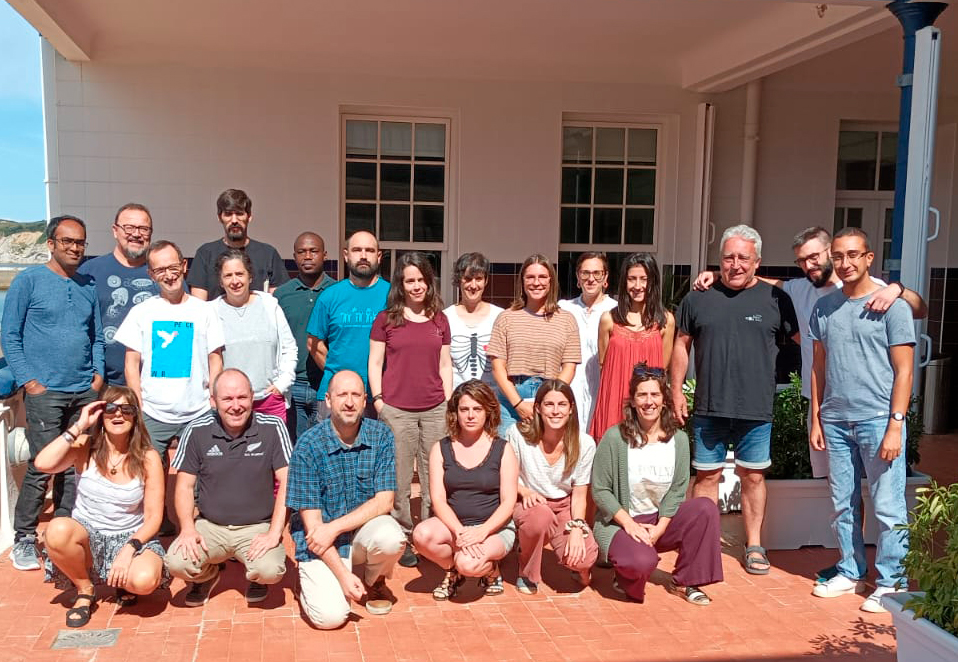Presentation

Since 1985 the group of “Cell Biology in Environmental Toxicology” (CBET) of the University of the Basque Country develops research and teaching activities within the Environmental Toxicology field (both aquatic and terrestrial ecosystems). The group, recognized since 2001 as type A consolidated research group (UPV 00076.310-13622/2001, period 2001-2006; GIC07/26-IT-393-07, period 2007-2012; GIC12/IT-810-13, period 2013-2018 and GIC19/IT-1302-19, period 2019-2021), is composed of 10 university lecturers and researchers, 5 postdoc researchers and 15 PhD students. Together with other two groups formed the Unit of Formation and Research UFI “Protection of Ecosystem Health”11/37 with funding in the period 2012-2016. The group´s labs contain facilities for histology, light, fluorescence and electron microscopy, image analysis, cell fractionation and biochemistry, cell culture and molecular biology. The group has aquaria facilities for development of large experiments and mesocosm experiments and a zebrafish facility at the Faculty of Science and Technology and at the Research Centre for Experimental Marine Biology and Biotechnology, Plentzia Marine Station PiE-UPV/EHU. The group coordinates three Masters (two recognized with the Erasmus Mundus label) and two Doctoral Programmes (Environmental Contamination and Toxicology CTA/ECT, Marine Environment and Resources MER) and offers several international postgraduate courses.
The main field of expertise of the group is in development and application of early warning cell and molecular biomarkers of pollution exposure and effects, and in toxicity profiling of environmental pollutants using standard and novel toxicity tests in cells in vitro, algae, invertebrates and vertebrates, including the model zebrafish and other fish species.
The group has developed a novel biomarker, peroxisome proliferation, useful as exposure biomarker of organic pollutants such as PAHs and recently adopted by different european labs and implemented in international programmes such as UNEP´s MEDPOL. The group also developed a battery of toxicity tests in vitro with mussel haemocytes as marker of immunotoxicity and a second battery with mussel gill cells. The group measures routinely several well-established biomarkers of pollution (lysosomal membrane stability and enlargement, EROD activity, metallothionein-MT levels, antioxidant enzymes and oxidative stress, vitellogenin-Vtg levels, DNA damage-Comet assay, micronucleus test, histopathology), participating in several intercalibration trials for (BEEP, BEQUALM, UNEP-MEDPOL). Recently the group incorporated the proteomic approach to search for protein expression signatures as novel integrated biomarkers. The group is also investigating changes in gene expression after cloning of several target genes in different sentinel species and has developed DNA microarrays in mussels, mullets, eels, or earthworms. Special areas of interest are the elucidation of mechanisms of chemical carcinogenesis, endocrine disruption and nuclear receptors (PPARs, ER, RXR). The group has been involved in monitoring of biological effects of pollution along the Basque coast, Mediterranean coast, Wider Caribbean region, North Sea, Baltic sea and the Arctic. Involvement of the group in the management of the Prestige oil spill through participation in national and regional expert committees and the short-, medium- and long-term assessment of the biological consequences of the disaster.
Participation in EU or international projects: XENOFISH (Impacts of marine xenobiotics on european commercial fish- Molecular effects and population responses, IV FP, FAIR, 1998-2000), BEEP (Biological Effects of Environmental Pollution in Marine Coastal Ecosystems, V FP, Environmental Programme-Marine Ecosystems, 2001-2004), PRAGMA (A pragmatic and integrated approach for the evaluation of environmental impact of oil and chemicals spilled at sea: input to European guidelines, VI FP, Environment DG, 2006-2007), NANORETOX (The reactivity and toxicity of engineered nanoparticles: risks to the environment and human health, VII FP, NMP-Nanosciences, Nanotechnologies, Materials and new Production Technologies, 2008-2012), POLARISATION (Polar cod, lipid metabolism and disruption by polycyclic aromatic hydrocarbons, Norwegian research Council, 2012-2015), ENTER (The transfer of engineered NanoMaterials ENMs from wastewater treatment and stormwater to rivers, COST Action ES1205, 2013-2017), PLASTOX (Direct and indirect ecotoxicological impacts of microplastics on marine organisms, EU JPI Oceans MarinERA, 2016-2018) and GRACE (Integrated oil spill response actions and environmental effects, H2020, Topic BG-07-2015, 2016-2019).
For the new period 2019-2021, in view of new trends and advances in the field of Environmental Toxicology during recent years, including the emergence of new hot topics, the group will structure its scientific activities around three related research areas, namely:
- Toxicology of nanomaterials, microplastics and other emerging pollutants.
- Reproduction and sex differentiation in aquatic organisms under environmental change.
- Integrated assessment of ecosystem health and pollution in aquatic and soil systems.
In addition, there will be four transversal strategic actions and scientific activities that are of common interest to the whole group and in which all of us will participate:
- Strategic framework and networking
- Development and implementation of novel technologies, methods and tools
- Higher education
- Dissemination and visibility
Key words: Environmental Toxicology, Ecosystem Health Assessment, Biomonitoring, Cellular and molecular biomarkers, Histopathology, Reproduction and sex differentiation, Environmental Risk Assessment, Toxicity profiling in vitro and in vivo, Alternative test methods, Emerging pollutants
